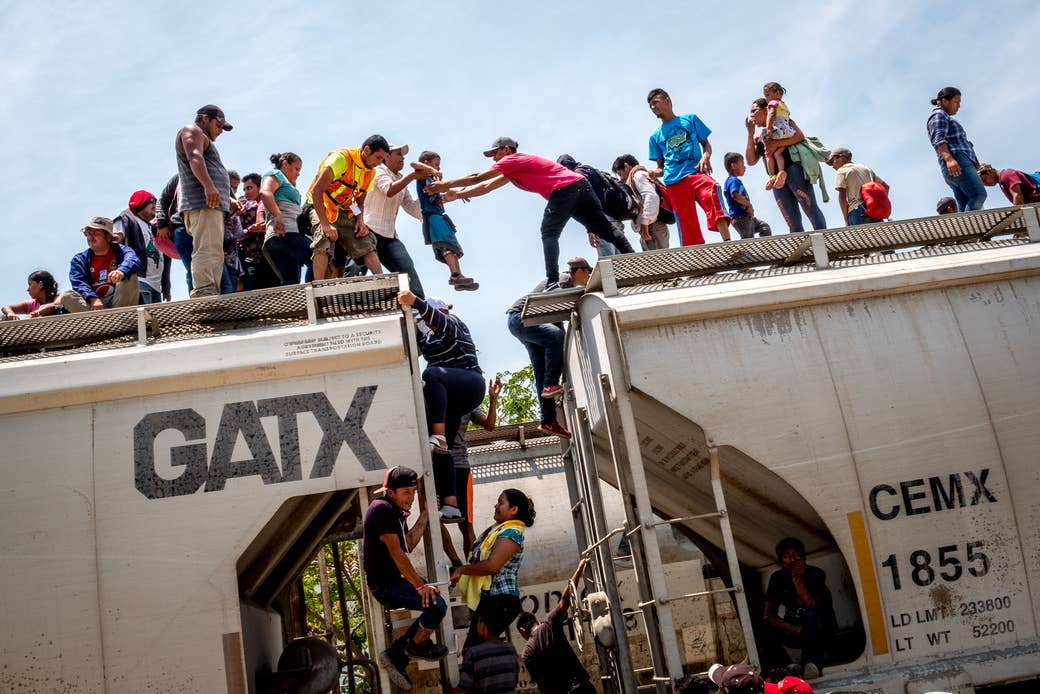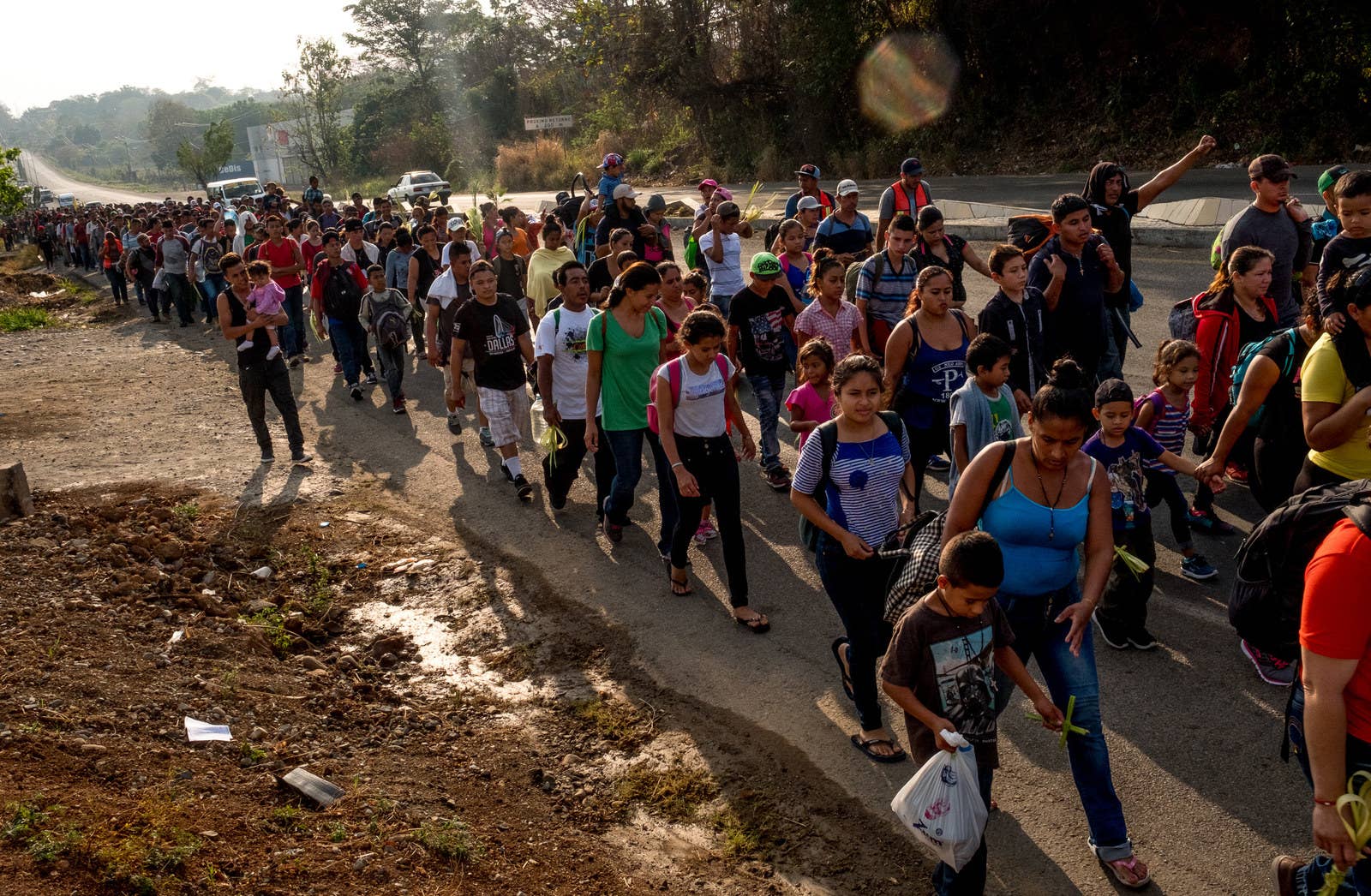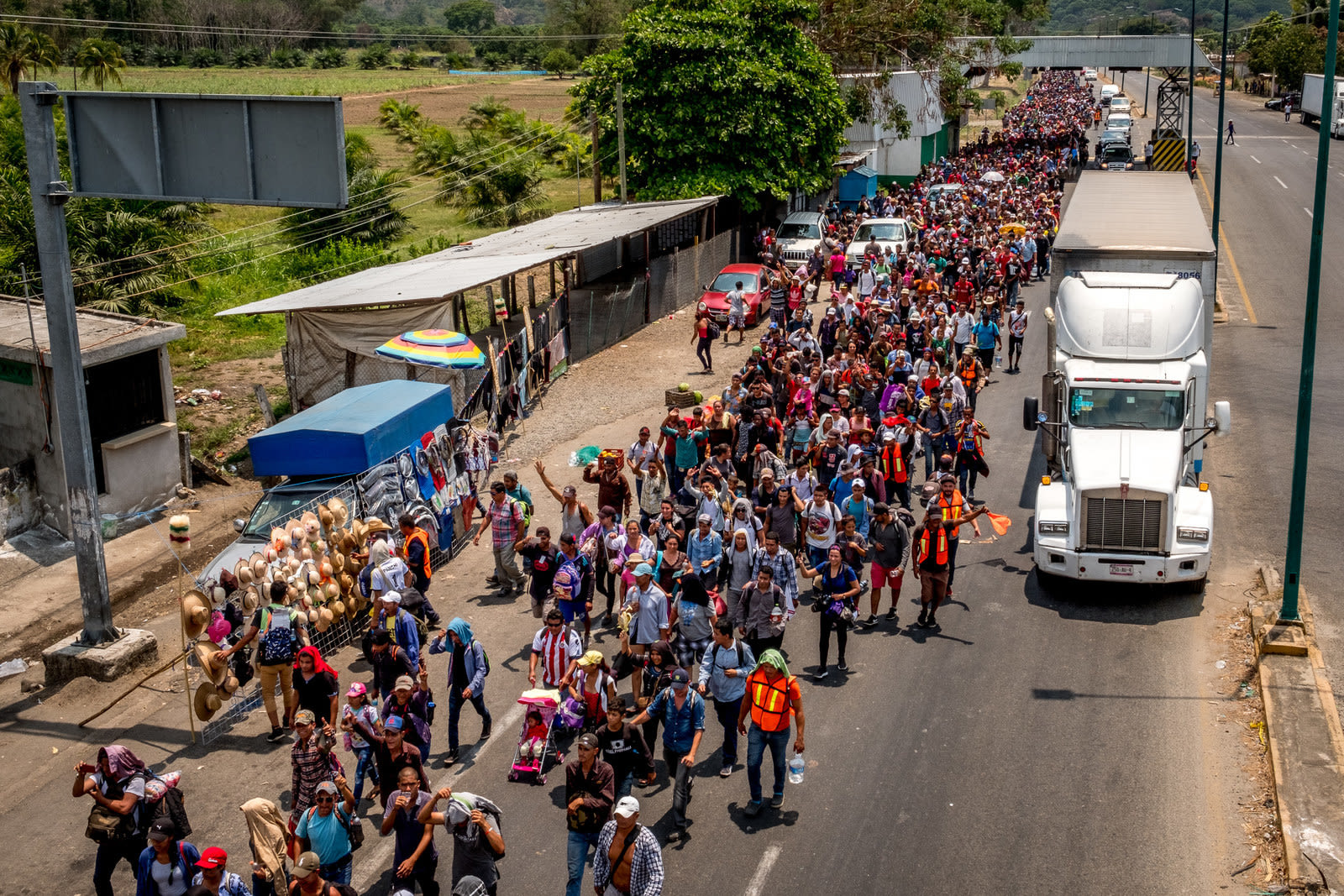Taking a drag from her cigarette, a Mexican immigration agent looked out toward a caravan of migrants that grew larger with each step they took on the two-lane highway.
When the agent, who’d covered her uniform with an orange and white shawl, learned that the Central American migrants heading her way numbered more than 1,000, she took off for the restaurant across the street.
“I’m going to have a relaxing Coke,” she told BuzzFeed News.
For five days now hundreds of Central Americans — children, women, and men, most of them from Honduras — have boldly crossed immigration checkpoints, military bases, and police in a desperate, sometimes chaotic march toward the United States. Despite their being in Mexico without authorization, no one has made any effort to stop them.
Organized by a group of volunteers called Pueblos Sin Fronteras, or People Without Borders, the caravan is intended to help migrants safely reach the United States, bypassing not only authorities who would seek to deport them, but gangs and cartels who are known to assault vulnerable migrants.
Organizers like Rodrigo Abeja hope that the sheer size of the crowd will give immigration authorities and criminals pause before trying to stop them.
“If we all protect each other we’ll get through this together,” Abeja yelled through a loudspeaker on the morning they left Tapachula, on Mexico’s border with Guatemala, for the nearly monthlong trek.
When they get to the US, they hope American authorities will grant them asylum or, for some, be absent when they attempt to cross the border illegally. More likely is that it will set up an enormous challenge to the Trump administration’s immigration policies and its ability to deal with an organized group of migrants numbering in the hundreds.
The number of people who showed up to travel with the caravan caught organizers by surprise, and has overwhelmed the various towns they’ve stopped in to spend the night. Pueblos Sin Fronteras counted about 1,200 people on the first day.
About 80% of them are from Honduras. Many said they are fleeing poverty, but also political unrest and violence that followed the swearing in of Honduran President Juan Orlando Hernández after a highly contested election last year. The group often breaks into chants of “out with JOH.” They also chant “we aren’t immigrants, we’re international workers” and “the people united will never be defeated.”

Luc Forsyth for BuzzFeed News
Migrants hitchhike along the side of the highway as they move toward the city of Mapastepec, Chiapas.
Sweating after miles of walking in more than 90-degree heat with her two kids, Karen said conditions in Honduras were so bad she decided to take a chance with the caravan. She declined to give her full name.
“The crime rate is horrible, you can’t live there,” Karen told BuzzFeed News on the side of a highway near Huixtla, a town in Chiapas, Mexico’s southernmost state. “After the president [was sworn in] it got worse. There were deaths, mobs, robbed homes, adults and kids were beaten up.”
Before setting out on the journey, the migrants were organized into groups of 10 to 15 people, and a leader was designated for each group. Five groups were then banded together in what organizers call a sector. While there are organizers from Pueblos Sin Fronteras leading the way, much of the effort to get to the US border is in the hands of the migrants themselves.
They’ve been organized into security, food, and logistics committees. Organizers say it’s meant to help the migrants empower themselves.
Sandra Perez, 40, who’s also from Honduras, is one of two women who belong to the security committee. It’s not her first caravan: She has traveled with a procession of Central American mothers through Mexico in search of disappeared migrants.
“I like doing this, it makes me happy and I feel useful,” she told BuzzFeed News.
Twenty-nine-year-old Mateo Juan said the caravan was his third attempt at getting to the United States. Seven months ago, Mexican immigration officers pulled him off the bus. The same happened about a month ago.
He heard about the caravan in March when he arrived in Tapachula, the caravan’s starting point.
“Going alone is risky. You’re risking an accident, getting jumped by robbers, and even your life,” he told BuzzFeed News. “All of that, and then you don’t get to the United States. The caravan is slower but you know you’re going to get there safely.”
Still, there are no guarantees on the route or assurances that once they reach the US border they’ll be able to cross undetected or be allowed to stay under some type of protection like asylum.
Alex Mensing, another organizer with Pueblos Sin Fronteras, made that point clear to the migrants before the group started out. He also stressed that everyone is responsible for their own food, water, and payment for vans or buses. Still, it’s far cheaper than being assaulted or falling into the hands of unscrupulous smugglers.
“I’m here to work together with the people who had to leave their countries for whatever reason,” Mensing said through a loudspeaker. “We’re fighting together. We’re not here to give anyone papers and we’re not here to give anyone food.”
Mensing said Pueblos Sin Fronteras isn’t calling on people to make the trek, but if they’re going to try to go through Mexico on the way to the United States, the group will help them.
The caravan propels itself forward using whatever way it can. Sometimes that means packing into the back of a truck, negotiating lower rates for vans, or hitching a ride on the back of empty big rigs from whatever town they’re in. The group sleeps in town plazas. Local townspeople and churches feed them.
On Tuesday, the caravan had plans to board the freight train known as “the Beast” or sometimes “the Train of Death” in Arriaga to speed the journey north. It’s a dangerous part of the journey, with death and injury only too possible from a precarious perch atop a rail car, and the group practiced boarding, one woman in a purple shirt slowly making her way up a parked train’s ladder while the crowd below cheered her on. On another train car, men wearing backpacks steadily made their way up one by one.

Luc Forsyth for BuzzFeed News
Migrants practice boarding “La Bestia,” the infamously dangerous train that will carry them toward the US border.
“This is so the women and children can lose their fear, know what it’s like to board the train, and turn back if they want,” Irineo Mujica, director of Pueblos Sin Fronteras, told the crowd.
But the train Mujica hoped would move the entire group to Puebla, one of their stops, never came, and in the end the group boarded trucks and school buses to cover the distance to San Pedro Tapanatepec, a town in the Mexican state of Oaxaca.
The move to the trucks was frantic, as people jostled for the limited space, and the security committees made a chain to hold people back. Mostly women and children wearing backpacks and carrying jugs of water got on the first truck.
Moving the entire group took hours, and some of the men, unable to gain a space in the vehicles, walked all night to join the rest of the group. On Friday, Good Friday, the organizers hope to board the Beast at another location.
Mujica said he was left with a sense of disbelief at seeing so many people go through such hardship in search of a better life.
“I can’t imagine my son walking on top of these trains. I can’t imagine hiding my children just to get to a city that’s four hours away,” Mujica said. “These are good people who are suffering as if they were slaves and putting their kids’ lives at risk. But it is what it is.”
UPDATE
By Friday afternoon, plans to make it to another train stop had fallen through, and the caravan set up camp in Santiago Niltepec, in Mexico’s Oaxaca state. Several of the buildings in the municipality are still cracked and crumbling from an earthquake that struck in February. But migrants took shelter in them anyway as it began to rain. Many of the people were wondering when, or if, they’d be able to board “the Beast” for the journey north.

Adolfo Flores is a national security correspondent for BuzzFeed News and is based in Los Angeles. He focuses on immigration.

